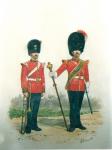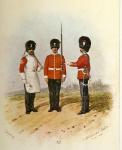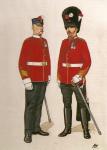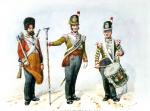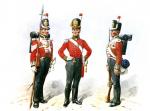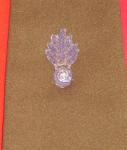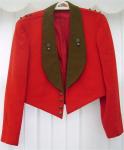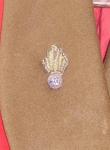-
Posts
1,065 -
Joined
-
Last visited
-
Days Won
1
Content Type
Profiles
Forums
Blogs
Gallery
Events
Store
Everything posted by Graham Stewart
-
Now for some characters from the Northumberlands showing change of dress over the years. Firstly Lieut K.Tynte, supposedly taken c.1865. However his collar rank, a crown would be that of a Major and so must have been taken some years later. The cap is interesting as the first were of sealskin, shortly replaced by those of racoon. Later the officers of Fusiliers regiments would adopt those of Bearskin. The plume here is of feather and always had been for NF officers, whereas the O/R's wore the more durable horse hair plume.
-
Very interesting Stuart, as in all my time the 5th always referred to their adornment as a "plume", whether it be of horse hair or feather. In the RNF Topic section I refer to my first introduction to the general descriptive wording "hackle" for the feather item worn by the Black Watch when wearing the SD Balmoral c.1902. From this period it seems to depend on what the material was made of and with what it was worn - but the word "hackle" seems more common to the small feather items, whereas the larger feather items worn by either officers or Rifles are described as "plumes". With the introduction of the beret for Fusiliers the word "hackle" is used from the beginning. of it's introduction. I can't dispute Stuarts DR reference to the use of the word "hackle" and it's dating, but in general terms among it's wearers and uniform historians "plume" seems to take precedence over "hackle" until the turn of the century.
-
Not an easy one to answer really, as in my time collecting and researching the first time I came across the word "hackle" was for the feather plume worn by the other ranks of the Black Watch, wearing it with the khaki Balmoral cap from around 1902. It would appear that from this period those items made of horse hair were more often described as "plumes", for instance the red & white plume worn by the other ranks of the NF in their fur caps was made of horse hair, but never described as a hackle. This seems to continue throughout the period where you have head-dress which is adorned by one or the other i.e. FSH or full dress and yet large feather items as worn in the astrakhan caps of the KRRC and RB etc, are still referred to as "feather plumes". With introduction of the beret for Fusiliers it appears that the word "hackle" surfaced immediatley and has stuck ever since, as did any feather item worn with Balmorals by Scottish Regiments.
-
The final one - c.1905. The Drum Major & Bandsman. The pointed cuff, with gosling green facings on the Bandsman indicating the new pattern of scarlet jacket introduced c.1905, which was worn until 1913. The shoulder strap was scarlet piped white with white worsted embroided titles - "Bomb/N.F.". Curiously Simkin, despite his faults, was the only one to correctly show the large red & white plum, which swept over the crown of the Drum Majors bearskin.
-
A Simkins print c.1890 - A Pioneer, O/R & Officer. The white facing introduced in 1881, would be worn until the turn of the 1900's, when gosling green facings would be re-adopted, but with the "jam-pot" cuff. However it was the new regular 3rd & 4th Battalions raised for the South African war which would introduce this, as both the 1st & 2nd Bn's were serving in South Africa.
-
I'll finish off with three more which will take us from 1881 to 1914, the pattern of dress being more well known to our readers. This is one of my favourites by Brian Fosten - a Quartermaster Sgt and Officer dressed for mounted duties. The Fosten brothers were outstanding uniform researchers/illustrators and their series in the Military Modeller during the 1980's was superb. This ended up in a full blown volume "The Thin Red Line", which is a "must have" book for all of those interested in British Military uniforms.
-
The only true "falling" plume that I can think of, is this one as worn with the Albert Shako - however I can't remember the date period for it's wear. All of my other prints in which the shako is worn show upright plumes. I think I'm also right in saying they were the only infantry regiment to wear a bi-coloured plume, as the rest of the infantry just wore white.
-
From the 22nd Bn, War Diary;- Ref. Map TOURNAI No.5 8th November 1918;- "Weather very wet. Battn still in support. Made preparations for an attack on Canal. Moved forward to leap frog R.I.F., but found the enemy had evacuated the position East of the Canal." 1 O/R wounded 8/11/1918 9th November 1918 - 0650;- "Erected bridges and crossed the Canal, obtained our objectives, by 0600 hrs. The objective was line of Railway from V.22.d.3.7 to V 15.b.9.9.. Remainder of day was spent in patrolling." 10th November 1918;- "Examining Posts were posted at every exit from ANTOING, which we had occupied and Scouts made systamatic search of all likely places for any Bosche, who may have been left behind." 11th November 1918 - 1100;- "Coy's at disposal of Coy Commanders. Armistice commenced."
-
A mess dress jacket belonging to Captain John Armstong Hardman Sanderson, who had originally been commissioned into the Royal Air Force Reserve of Officers(Admin Branch). He too transferred to the Regular Army and was commissioned 2nd/Lt in RNF on the 10th Sept 1956 and on the 16th Oct 1956 he was promoted Lieut. The jacket overall is made of a slightly lighter material than Aytons.




